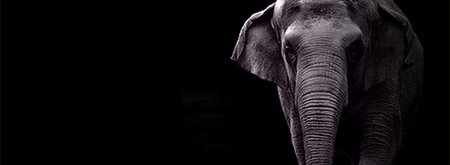The Blind Men, the Elephant and the Zoo
The story of the blind men and the elephant is well known, but here is a lesser known account of the blind men in a parallel universe visiting a zoo. This second story is far more interesting and, I would argue, far more enlightening.
The traditional story of the blind men and the elephant
For those unfamiliar with the traditional story of the blind men and the elephant, here it is:[1]
Six blind men encounter an elephant – although how they knew that it was an elephant the story does not recount. The first touches its trunk and says that an elephant is like a palm tree, another touches its side and says that an elephant is like a rough wall. Another feels its tail and says that an elephant is like a piece of rope. Each comes into contact with a different part of the elephant[2] and is convinced that their own explanation is correct and that the others are wrong. None of them realises that they are all experiencing just one part of the same elephant and that none of their explanations are complete.
In the same way, so it is argued, different religions experience different parts of ‘God’ but fail to realise that each is just one part of the complete truth.
The problem with this interpretation of the parable is best phrased as a question: How does the interpreter know that every religion is just a part of the overall conception of God? In order to know this, one would have to be able to see God in all his fullness and understand how each religion reflects just a part of that complete picture.
The updated story of the blind men and the zoo
Here is an alternative version of the story, which to me rings far more true about mankind’s search for God.
Six blind men [3] are in search of an elephant, to discover what it is like. So they visit a zoo [4] and go their separate ways, exploring the animals with which they come into contact. One man goes up to the first animal that he encounters – a camel giving rides. He decides that it is an elephant. After a thorough investigation, he concludes that elephants are hairy, with two humps on their back, foul breath and long thin legs. The second blind man passes the elephant, ignoring the Braille sign next to it. Soon afterwards, he encounters an ostrich and concludes that this is an elephant, with feathers, two legs and a rather dangerous beak. The third and fourth men have equally unfruitful encounters with other animals. The fifth blind man ends up at the elephant enclosure and, oblivious to everything else around him due to the volume of his iPod, concludes that an elephant is like a castle, with four columns to support the armoured walls and two spears jutting forward either side of a large hollow hosepipe, which must be used for washing away its enemies.A little later, the final blind man also reaches the elephant enclosure, having consulted the Braille direction signs scattered around the zoo and having asked one of the many friendly zookeepers in order to ensure that he really was in the right place for the elephant. Feeling his way around the elephant, this man mutters to himself, ‘I wonder what an elephant is really like.’ To his amazement, he hears the reply, ‘If you really want to know, I will show you.’ Immediately, his vision clears and he can see the whole elephant. He engages the elephant in earnest conversation until closing time, finding out just what the elephant thinks about the zoo, the visitors and the surroundings. At the same time, the man carefully takes note of all of the elephant’s characteristics.
On meeting up with his friends on the bus home, the sixth man finds that his friends have different and strange ideas about what an elephant is, but none of them have any idea what an elephant is truly like. The formerly blind man, now sighted, explains to them his own encounter with the elephant – not just what it feels like, but that an encounter with this elephant can literally open their eyes and ears and reveal the inner nature of the elephant. Some believe him and return to the zoo to encounter the elephant for themselves. The others ignore him, continuing to listen to their iPods or dismissing him as crazy.
The moral of the story [5]
Most of the blind men did not encounter an elephant at all – despite the signs and the zoo keepers giving directions. Of those who did, one reached only a limited understanding of the elephant – the pleasures and cares of the world deafening him to the words of the elephant. Only one man truly encountered the elephant, being open to what the elephant wanted to reveal to him.
In mankind’s search for God, people can fumble around on their own, seeking to know what they cannot, by themselves, hope to grasp. Indeed, many look entirely in the wrong place, ignoring the signs that are pointing to the one true God, while others are too busy trying to distract themselves from the realities of life with various pleasures and activities. People’s different interpretations of God are not necessarily aspects of one truth, but descriptions of entirely different things – not an elephant, but a camel or an ostrich.
References
[1] The story occurs in many forms and appears to have Buddhist, Hindu, Islamic and Jain versions. In the nineteenth century, American poet John Godfrey Saxe (1816-1887) put it into verse and it is probably this version which is best known today. It can be accessed from here.
[2] An addition to the story by American cartoonist Sam Gross has another blind man encounter a small mound near the elephant and conclude that an elephant is soft and mushy (and presumably smelly).
[3] Perhaps this should read ‘visually impaired people’, but for parity with the previous story I stick to the politically incorrect terms, with apologies to all concerned.
[4] The zoo is, fortunately for our story, rather lax in its application of health and safety precautions, allowing the blind men almost free access to the animals.
[5] Note that this illustration is meant as a response to the traditional story and interpretation of the story of the blind men and the elephants. It is not meant as a proper allegory. Most of the details are unimportant and can be adapted to suit the audience. The key message is vital.
© 2007 Chris Knight



